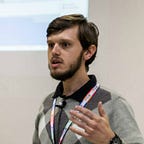The first step
Every journey has a start. I share with you the start of my Android app project journey.
Some days ago I shared my project of creating an app. Now, it is time to share a bit about my first step: defining the app and it’s features. This kind of definition often takes some time and a good effort. In my case, all I want is define is the goal and the concept. Despite of looking simple, some things must be done before.
Doing the homework
I am used to read a lot about app development. Besides of the technical stuff about Android, I like to read about the market, the opportunities and challenges that surround the app economy. By that reason, there are countless sources that influenced this project. Actually, this is my first tip: read a lot, from many sources. That will certainly create a nice panorama about the app market in your head.
From the many resources available, one that certainly influenced in a direct way this project is “The Mobile App Developer Bussiness Kit” from Google’s AdMob team. The kit contains a lot of important data about the current state of mobile app landscape, with survey results, interviews and tips. I did the reading twice, highlighting the important things. Those highlights are on my watch always. Probably I will go back to them many times until the app is released.
I also like the post “How I got 2.3 million app downloads” from Stuart Hall. That’s another great resource, full of lessons learned from a very successfull app. Despite of talking about the Apple App Store, the post is also very relevant for developing Android apps for Google Play Store.
Of course, some resources for startups may also be useful. “ What Your Survival Instincts Know About Pitching Ideas” is a nice article about startup pitching that can be easily applied to the creationg of an app.
Another great resource is the Google Play Store itself. There are so many good apps that can used as inspiration available for free. Off course, there is a lot of bad apps too. Both of cases can be used as samples of what to do or not to do. Downloading and testing apps in a daily basis can be a good source of knowledge.
To craft the goal
For me, a successful app always have a clear goal. An app that tries to do too many things, often ends performing all those things poorly. In the other hand, an app with no clear goal often ends in a confusing or useless experience. For that reason, my app has a very clear goal. That will be very clear the day you download and test the app for the first time, I promise.
To find the goal it was not as hard as I expected. Probably because I have been thinking around this ideia for a while. I made several tests with apps that almost reach the same goal that I have. The problem is that, today, to fully reach what I want, you have to use multiple apps and connect data manually. Therefore, I am thinking about an app that merges different features into a more complete thing. But calm down, those features are not that big :)
Defining the MVP
The concept of Minimum Viable Product (MVP) is very important to me. It is quite obvious that, if my app take too long to go live, it may loose timing. Someone can deliver the same thing that I am doing before, reducing my chances of success. More than that, there is also the risk that I spend too much time doing something that nobody wants. On the other hand, if I make something incomplete public, I may harm the product image before it is even done.
For that reason, I spent a good time thinking about what is the best size for the first version. I made some sketches on a notebook and took some notes. Nothing too much advanced, but complete enough to give the idea for the first public version. This version will have everything that is needed to reach the app goal, but in a simple and not totaly flexible way. That will arrive in later versions.
Money is important
Usually, money is more important than I like to admit. For an app that uses backend resources, the bare minimum expected is to make money enough to pay the costs. Off course, the time spent in development must also generate some money. For that reason, monetization must be on the radar very soon in the app project. In my case, the revenues streams are already on study and will certainly be present since the first public version. I don’t expect to make millions, but I want to pay the costs.
Putting the pieces together
With a goal and a MVP defined, it is now much easier to start crafting something more concrete. The goal will be present all the time, filtering ideais and possible features and even giving some priority to them. It is true that the goal may suffer small changes or even get refined. But the point is that it will be always in my mind, avoiding misleads or non important features. The MVP is reflecting of that goal and the features with more priority. Finally, the monetization strategy is connected to the goals and features, in a way that it can generate some revenue without compromising the app.
More news soon
This second post took some time to be available, I know. My work now is to share something new with you very soon, probably in the next few days. Stay tuned!
Cover: Unsplash
